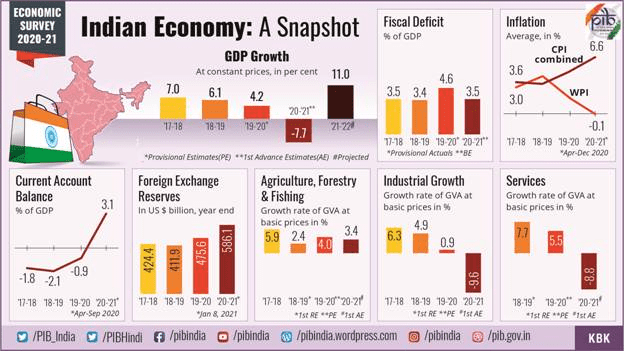Fiscal policy is an important policy instrument that influences economic growth through a direct impact on aggregate demand, and consequently, total income in an economy. Fiscal policy can be of two types, expansionary or contractionary with the main tools being government expenditure and taxation. In India, it is commonly seen that the government’s expenditure on economic activity is governed by fiscal policies which also determine the level of revenue to be earned to stimulate the smooth operation of the economy. One of the primary fiscal policy objectives, as stated by the Government of India, is to attain accelerated economic expansion.
Source – pib.gov.in
The economic growth in India has been declining for the past few years, even prior to the advent of the novel coronavirus pandemic in the year 2020, which has raised serious questions about the effectiveness of the fiscal policies being adopted by the present government. The COVID-19 pandemic has caused major supply and demand-side shocks to not only the Indian economy but also theworld economy. However, India has been particularly affected with the macroeconomic determinants being adversely affected to a great extent.
The already growing fiscal deficit, of the Union and State combined, has undergone a significant positive trend, being expected to exceed 10% of estimated GDP by the end of 2021, which is a cause for great concern for the economy. The debt to GDP ratio of the Indian economy is expected to be well above the new threshold set by the FRBM Act in 2018, which can negatively affect economic growth and development.
Even the Central administration acknowledges the necessity for a fiscal policy in the form of a relief package to stimulate the economy through increased public expenditures, however, the government is constrained because financing growth through increased expenditure without the formulation of stringent public revenue policies would only increase the fiscal deficit which would have damaging consequences for the economy as a whole. These concerning figures are results of poor fiscal policies which have so far not been very effective in meeting the primary target of boosting economic development.
According to D.K. Srivastava, it has become essential to reframe the fiscal policy framework of the government owing to the increasing ineffectiveness of the policies adopted in bringing about any significant difference to economic growth or development in India, considering the needs of the Indian people.
Source – www.indiatoday.in
In recent times, an important example of poor fiscal policy is the increased excise duties on petroleum products by the government to generate high revenue and consequently lead to high public expenditure, to cause economic revival. However, this policy is countercyclical and leads to the imposition of financial burden on the people through increased petrol prices and might actually decline aggregate demand instead of boosting it, leading to adverse economic conditions.
This is because not much government expenditure can be financed through the duties on petroleum products and the impact of the expansionary fiscal policies, in this case, can be offset by crowding out of personal consumption owing to increased prices, leading to a net negative effect on the national income through decreased aggregate demand.
The main problem with the existing fiscal policy framework is that the government tries to attain a greater revenue through indirect taxes on normal consumption goods rather than indirect taxes on investment or consumption goods by capitalists which would actually revive the economy by demand-expansionary effect because of increased purchasing power in the hands of the capitalists due to the income and wealth inequality in the country. The cost-push effect of the inflationary rise in petrol prices has adversely affected economic growth by dampening demand in the country. The unsuitable fiscal policy by the government can be directly responsible for such inflation.
Moreover, the Atmanirbhar Bharat Abhiyaan, that is, the fiscal package provided by the Indian government to help the people during the pandemic was heavily criticised by economists who disregarded the capacity of the package to drive long-run economic growth through a sustained increase in demand. It was felt that the stimulus was not enough to generate meaningful growth and development. The amount of economic downfalltriggered by the pandemiccould not be curtailed by the relief package, which caused a 23.9% contraction in the economic growthduring the second quarter of 2020. According to Aurodeep Nandi, the package was merely 1.2% of the GDP, which is significantly smaller than the blow to the economy and also portrays the fragility of the country’s fiscal standing.
Source – www.indiatoday.in
Economists had estimated that to support the vulnerable population of the country, including the migrant workers and slum dwellers, and the MSMEs, the minimum fiscal relief package should have been more than 5% of the GDP, as compared to the 1.2% actually provided. The fiscal relief by the government of India was comparatively lower than the relief packages provided in other countries which reflected unnecessary priority to fiscal prudence by the government, even in such challenging times which called for radical and unconventional measures to boost economic growth.
The government, in an attempt to maintain low levels of fiscal deficit, provided the Aatmanirbhar package by cutting down on other expenditures, which also had grave consequences for the economy. Had the government maintained a solid fiscal policy framework, it would not have had to worry about increasing deficit and could have provided a greater stimulus package.
Thus, the fiscal policies so far have not been quite effective, and the government needs to address the drawbacks and make the changes accordingly. The Indian economy needs an expansionary fiscal structure at the moment which would not provide temporary relief but aim at long-run economic growth and development by targeting the problems of poverty and vulnerability from the grassroots through investments in education and healthcare.
Moreover, infrastructural improvement and income support are required to drive up employment and increase the financial stability of the people, which will drive up demand and thus, the economic growth in a post-COVID era. To avoid excess budget deficit, the government can increase indirect taxes on luxury goods consumed by the capitalists and increase the tax burden of the high-income tax slabs to not only generate high revenue but also drive down income inequality.
Written by- Soumil Basu
Edited by- Krish Sharma
The post Low Fiscal Effectiveness in India in Recent Years appeared first on The Economic Transcript.




